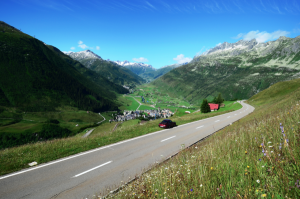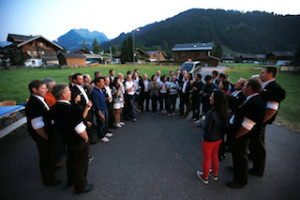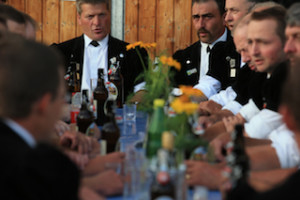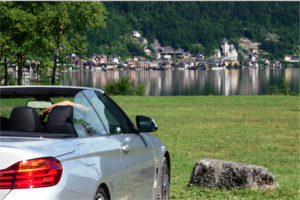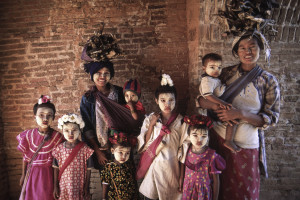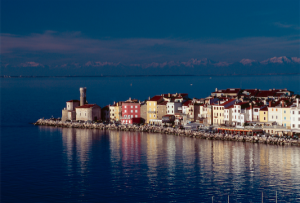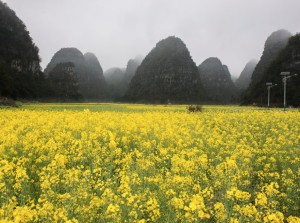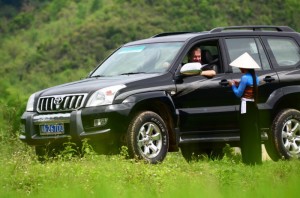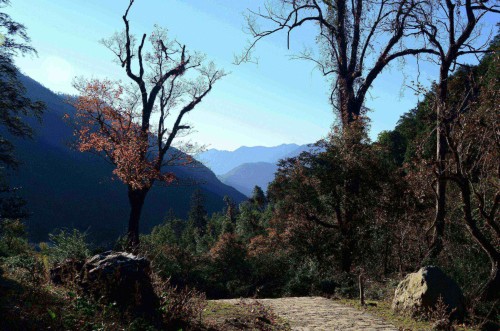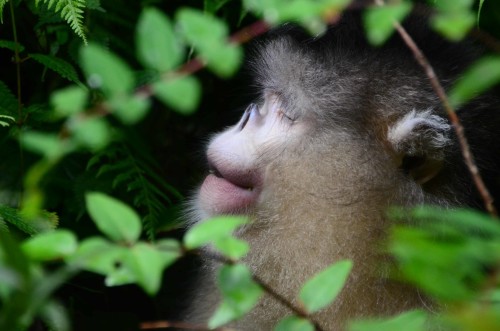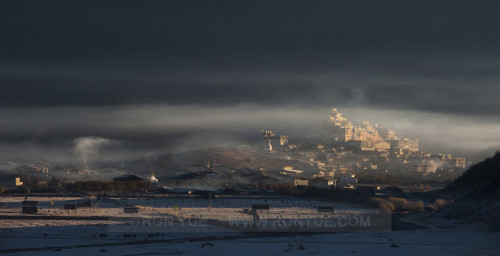Tag Archives: Back roads
Posted on 18 Dec, 2015
Welcome to our quarterly update, a whirlwind summary of what we’ve been up to in the past few months and what is to come in 2016 besides the smell of ginger bread cookies my wife will be baking in our kitchen this weekend.
Looking back…
The second half of 2015 stands out because we saw, at last, our first journeys in Europe. Given that “On the Road in the Europe” has been gestating for 15 years, it is with a great sense of pride that we can finally introduce our first itineraries in the Europe – to watch a beautiful video of our journeys in the Alps, click here.
I have two memories from our European journeys this autumn that I would like to share with you.
First, in Gstaad, a small Swiss town, we had arranged the surprise appearance of a Jodl (or Yodel) Choir to entertain our group while they dined on fondue one night. As the Swiss singers yodeled, they coaxed our guests to join their song.
Though initially shy, one of our Hong Kong guests suddenly seized the initiative and launched into a rendition of Teresa Teng’s classic, “The Moon Represents My Heart” (月亮代表我的心) for the Swiss yodelers, with the remainder of our guests swiftly joining him for the chorus. Despite their lack of a common language (the yodelers speaking a Swiss dialect that I found difficult to understand myself), the two groups sang to each other with moving warmth, and toasted each other with infectious enthusiasm.
On our second foray into Europe, I was immensely pleased when our guests all selected open-top cars, perhaps following my advice that, for our European journeys, you “can drive any car you like, so long as it is a cabriolet!” Even on the trip’s rare grey mornings, our small convoy would roll away from the last night’s hotel, each car with its top down. When we pulled into the next hotel’s driveway that evening, the tops would still be rolled back, having remained that way throughout the drive. It was wonderful to see so much enthusiasm for driving in the crisp, fragrant mountain air of the Alps. 一百分!100 points to all of the participants!
In the second half of 2015, our team grew with Peifen, Liu (劉佩芬) and Kayin, Chau (周珈妍) joining us.
Peifen is based in Taiwan. She brings a breath of fresh air into the development of our business there, and in a very short period of time she has turned many customers into fans of hers and On the Road.

Kayin
Kayin has joined our Hong Kong team and now takes care of “Operations” – all the things that need to happen before a group of guests can hit the road; reserving hotel rooms, renting cars, booking flights and a million other details. This role was formerly filled by Cathy Choi, who is now focusing on marketing our journeys in Hong Kong.
Looking forward…
We’re in the midst of developing two new journeys, one in Asia, and one in Europe:
2016 will see the launch of On the Road in Burma, if I can call it this. We have long wanted to offer driving journeys in this remarkable country, and in January and February we will complete our ground research so that we can – fingers crossed! – begin taking bookings for our first journeys there in November 2016. Stay tuned!
In March, we will continue our research for a new set of European itineraries in the former Austro-Hungarian Empire, with the focus on the Czech Republic, Slovenia and Croatia. Our initial research has been incredibly exciting and we can’t wait to share the gems of cultural and scenic beauty that we’re discovering in this region!
This look ahead wouldn’t be complete without a brief mention of our upcoming journeys:
Our all new photography journey in Yunnan takes in three of the province’s most photogenic places: the striking fields of red earth around Dongchuan, the golden sea of rapeseed flowers that surrounds Luoping’s otherworldly karst scenery, and the “Mirrors of God” paddy fields outside Yuanyang. The journey starts on March 4th – it’s not too late to make time to join Ron and our team!
Over Easter, our “Family Adventures: Travel Photography in Yunnan” journey with Ron is fully booked, but there are two border-crossing journeys – one from Shangri-La via Laos to Chiang Mai in Thailand ; the other from Kunming via Laos to Mai Chau in Vietnam – that you will not regret joining. The variety of cultures, cuisines, landscapes and roads you will experience along both these routes is sure to make the holiday especially memorable!
Happy Holidays!
And now off to Perth, Australia, I go to celebrate the holidays with my wife Angie’s large Chinese family. Since they can all drink – no faces turning red in this family! – and all love to cook, I am, as always, in for a treat.
I wish you, your family and friends, wonderful end-of-year holidays too and thank you for all your interest and kind support throughout the years.
Posted on 17 Dec, 2015
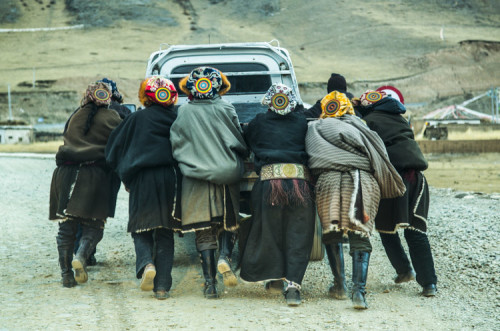 Most of my travel this year has been restricted to the armchair variety – reading about others’ journeys and reliving my own. My mind returns again and again to certain trips; a cycling tour of New Zealand and a very bumpy journey across Myanmar on public transport last year, and a meandering trip to Kashgar the year before. Eventually, I realised that my fondest memories were of the journeys where I felt that I made a connection with the place and the people I travelled amongst, journeys where I’d lingered rather than rushed.
Most of my travel this year has been restricted to the armchair variety – reading about others’ journeys and reliving my own. My mind returns again and again to certain trips; a cycling tour of New Zealand and a very bumpy journey across Myanmar on public transport last year, and a meandering trip to Kashgar the year before. Eventually, I realised that my fondest memories were of the journeys where I felt that I made a connection with the place and the people I travelled amongst, journeys where I’d lingered rather than rushed.
With everyday life often feeling like a hectic, headlong dash between home, work and social engagements, many of us wish to do nothing more on vacation than lie on a beach with a book. Others may prefer the other end of the spectrum and strive to fit as much as possible into a few precious days off, tearing across a continent on a breathless five-countries-in-four-days tour. Either option seems a reasonable reaction to the “time poverty” that we increasingly experience; however, another more meaningful way of seeing the world has recently gained popularity – Slow Travel.
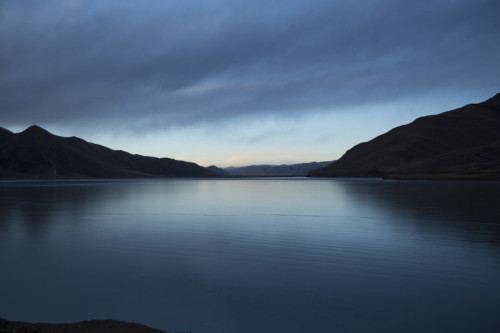 Slow Travel is an offshoot of the Slow Food movement, founded in Italy in the 1980s in protest against the opening of a McDonald’s outlet in Rome. The Slow Food philosophy, which celebrates regional cuisine and traditional farming methods, has since burgeoned into a movement that emphasises the connection between people, places and life in general.
Slow Travel is an offshoot of the Slow Food movement, founded in Italy in the 1980s in protest against the opening of a McDonald’s outlet in Rome. The Slow Food philosophy, which celebrates regional cuisine and traditional farming methods, has since burgeoned into a movement that emphasises the connection between people, places and life in general.
Slow Travel is less to do with your mode of transport (or your relative speed), but instead concerns your mindset on each journey. It means taking back roads, travelling overland rather than by air where possible, and focuses on forging a connection between traveller and destination. Instead of tackling a place armed with a list of “must-sees”, the slow traveller slips into the pace of the local culture and soaks in their new environment. It’s about not letting the anticipation of arrival undermine the pleasure of the journey.
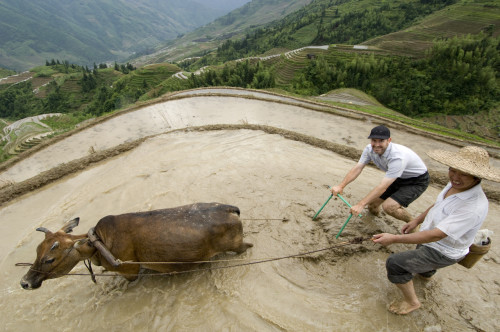 While Slow Travel is a new term, there’s nothing modish about the practice itself. Some of you will have instinctively travelled slowly before – stopping to observe local customs, interact with the people you meet en route and try local foods, preferring the quality of your experience over sheer quantity.
While Slow Travel is a new term, there’s nothing modish about the practice itself. Some of you will have instinctively travelled slowly before – stopping to observe local customs, interact with the people you meet en route and try local foods, preferring the quality of your experience over sheer quantity.
Through our experience of creating memorable driving journeys, we have become firm believers in the merits of Slow Travel. While crafting each of our itineraries we’re always on the lookout for what makes each of our drives and destinations special – whether it’s a spectacular view to soak up, a fantastic but out-of-the-way hotel, or even something as simple as a chance to dip your feet in a cool, clear stream on a hot day. We also enjoy searching for opportunities to bring our guests together with local people, whether that means joining a yodelling choir in the Swiss Alps or watching craftsmen at work in Lhasa’s old town. A journey is made as memorable by the people we share it with as it is by our destination, after all!
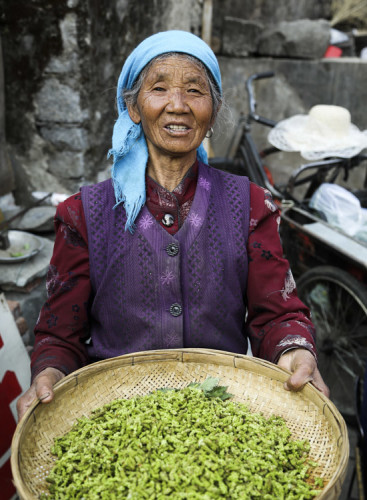 5 enjoyable ways to practice Slow Travel (even if you start at home):
5 enjoyable ways to practice Slow Travel (even if you start at home):
- Linger over a drink in a locally-owned café, bar or teashop
- Take a back-road or try a new way to get from A to B – turn down a street you’ve never used before
- Hunt out regional dishes and specialties, and visit a local market.
- Savour the unexpected – missed connections can create new opportunities
- Take a breath, check your stride and remind yourself to enjoy the pleasure of the journey.
To read more about the Slow Movement visit http://www.slowmovement.com/
Posted on 16 Dec, 2015
… to love what you do. We love what we do – creating the world’s greatest driving holidays for you!
We share our passion for driving journeys in this beautiful video about our newest adventure, On the Road in Europe:
For more videos, please visit this page…
Posted on 2 Dec, 2015
Everyone has heard of Shangri-La. Even for those who have not read James Hilton’s classic Lost Horizon, the name evokes visions of an earthly paradise tucked away amongst soaring mountain ranges, where humans live long and peaceful lives amidst pristine, otherworldly surroundings.
In northwest Yunnan there is a Tibetan town, historically known as Zhongdian. Perched at the south-eastern edge of the Tibetan Plateau and astride the main route to Tibet proper, the small town has long been a trading post and meeting point between Yunnan’s lowlands and highlands. Zhongdian’s compact old town was once filled with thick-walled Tibetan houses, yaks grazed in verdant fields around the town and stupas decorated the surrounding hillsides – undeniably picturesque, but still a far cry from Hilton’s fictional paradise.
Just over ten years ago Zhongdian’s enterprising mayor decided that since no one knew where Shangri-La was, it might as well be in Zhongdian. A pretext was fabricated (certain geographical features outside the town are said to resemble those mentioned in the novel) and Zhongdian was duly renamed Shangri-La, or Xianggelila in Chinese.
The new name and a new airport spurred a building boom that has seen old Zhongdian transformed into a somewhat ugly, modern town. Then, in early 2014 a devastating fire burnt much of the old town to the ground. Whatever faint resemblance the place may once have had to the Shangri-La of fiction, it has now gone for good.
So did the idea of Shangri-La go up in flames along with Zhongdian’s timber-framed old town?
The north-westernmost region of Yunnan is formally called the Diqing Tibetan Autonomous Prefecture. Shaped like a triangle balancing on one point, the region is composed of three counties; Shangri-La (with Zhongdian/Shangri-La at its centre) in the east, Weixi in the west and Deqin at the uppermost tip of the triangle. If you are looking for Shangri-La, stop briefly in Zhongdian/Shangri-La, if you must, but make sure you leave time to explore Diqing’s beautiful hinterland. While it might not exactly match Hilton’s description, the region is so lovely and holds such natural bounty and variety that any such qualms will quickly be forgotten.
Diqing is home to at least ten ethnic minorities. The largest of these is Tibetan, but there are also the Lisu, Naxi, Bai, Yi, Hui, Pumi, Miao, Nu and Drung, among others. Each speaks its own language, practices its own and religion, and wears – for the everyday, not for tourists’ benefit – its own traditional clothing. People are friendly and welcoming, especially in the remoter parts of Diqing where tourists are still rare.
Diqing straddles one of the world’s most bio-diverse regions, the so-called Three Parallel Rivers, named for a short-range geographical accident that sees three of Asia’s great rivers – the Yangtze, the Mekong, and the Salween – churn through lush, parallel valleys for several hundred kilometres. The Three Parallel Rivers region is home to many exotic and endemic species of flora and fauna. One of the most endearing is the Yunnanese snub-nosed monkey, one of the rarest primates on earth. Incredibly, it is easy to spot (and photograph) in a sanctuary of old-growth forest that lies in the mountains between the Yangtze and Mekong valleys.
The region’s human heritage and geography is no less rich and varied with a long list of little-visited, yet spectacular attractions. Each Sunday in the tiny village of Cizhong, a Tibetan priest holds mass in a nineteenth-century church built by French missionaries. Further north, there is the massive Meili Snow Mountain range. The highest peaks rise to over 6,000 metres, making for impressive prominence over the river valleys to the east and west. The highest peak is sacred 6,740-metre-tall Kawagebo, which – in deference to local religious beliefs – has never been summited.
While the mountaintops are left to local gods, it’s still possible to feel the magic of travelling through the mountains and climbing towards distant peaks on the ascent from lowland Yunnan to Diqing. Some may opt to fly straight into Zhongdian/Shangri-La, at the risk of both altitude sickness and a dislocating sense of culture shock. However, far better to travel overland, slowly acclimatising to the thinner air and absorbing the gradual change in your surroundings as the familiar trappings of modern life give way to something gentler and altogether rarer. By the end of your journey, you might just feel that you have, indeed, glimpsed Shangri-La after all.
If you would like to go in search of Shangri-La for yourself, you may want to take a look at this travel idea here.
Posted on 22 Nov, 2015
The first trip I led with Ron Yue, our team’s professional photographer, covered familiar ground. I had completed the itinerary through southern Yunnan several times before, both for research and with groups of guests, so I knew what to expect. Except that I didn’t.
Over the course of our week-long trip I discovered that travelling with a photographer is quite different to travelling without one. The pace is a lot more leisurely, for one thing, with plenty more photo stops, both scheduled and impromptu. The conversation over dinner tends towards discussion of f-stops and exposure compensation, and you return home with distinctly better quality holiday snaps. But the most significant – and unexpected – difference was that I discovered a fresh new beauty in those familiar places, thanks to Ron and to my camera.
Following Ron’s example and with his coaching, our group of photographers became more and more observant of our surroundings as we travelled. I found myself stopping more, enjoying scenes and noticing details that would have passed me by before. An everyday market was suddenly filled with unexpected moments of loveliness – a child playing amongst piles of chilli peppers lying around her mother’s stall, or an elderly lady deftly binding piles of damp, field-fresh herbs into bundles ready for sale.
If photography can help us to appreciate somewhere as down-to-earth as a local market, the impact of a truly splendid sight is magnified many times for the photographer. On that first trip, we visited one of Yunnan’s many photogenic landscapes, the Yuanyang rice terraces. Patterns emerged where before there were none, light danced over the landscape in a newly entrancing way and fleeting moments captured on film (or in pixels) still give me pleasure now, five years later.
By opening our eyes to the beauty that surrounds us, and by providing a keepsake to remind us of treasured moments, photography is a wonderful complement to travel, whether we’re documenting a family holiday or a once-in-a-lifetime expedition, whether we’re in the wilds of Yunnan or in the middle of a city. But maybe we can also bring that awareness back home, to help us reconnect with the beauty of the everyday, from the reflection of a vivid sunset on an office building to the warm smile of a loved one.
While our original photography itinerary (The Exotic South) took in just one of Yunnan’s iconic landscapes, the province has many more in store – as Ron says “there is an incredible diversity of colours and landscapes in Yunnan – plenty to keep a photographer busy!” Now, we have introduced a new photography journey that features three of the most beautiful landscapes on a single itinerary, Red Earth and Fields of Gold.
From the vivid red earth of Dongchuan to the limestone karsts and blazing yellow rapeseed fields around Luoping (and one of our favourites, the Yuanyang rice fields) generations of local people have dramatically added their own imprint to landscapes across eastern Yunnan, creating patterns that fuse the manmade with nature and creating scenes found nowhere else.

